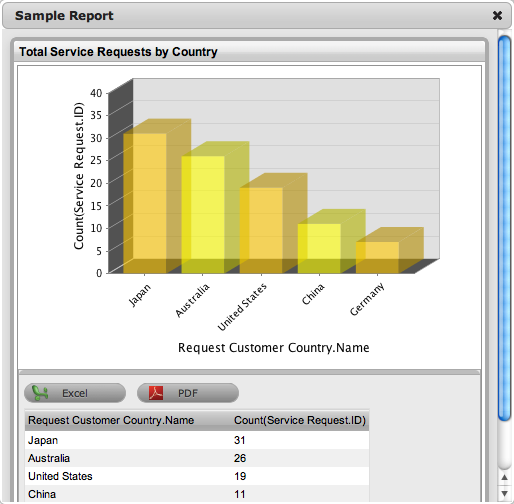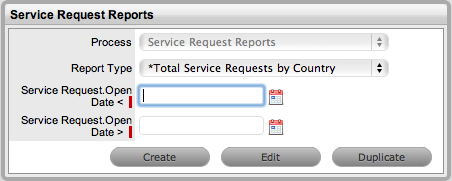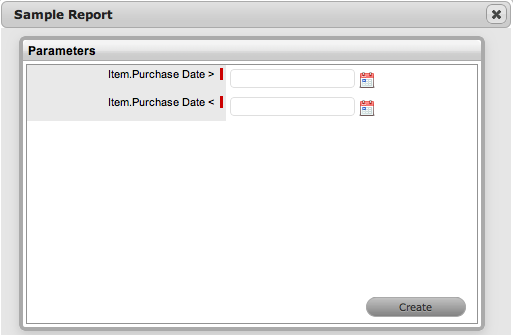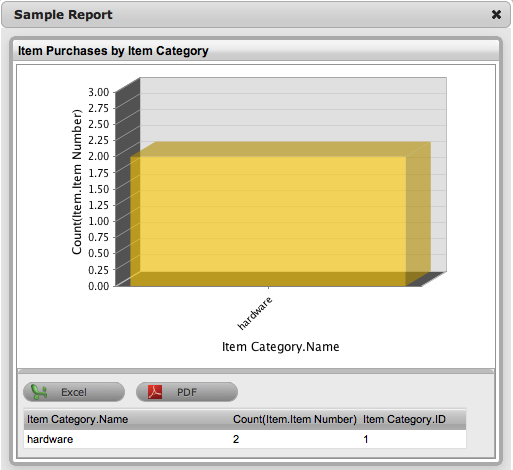Home > Builder
Report Builder
The internal system report builder is designed as a mid-range report
writing tool and does not replace report writing tools such as Pentaho.
It is intended to provide Users with the capability to build simple custom
reports without requiring in-depth knowledge of the database schema.
Reports can be built across:
All request types
Teams and Technicians
Items
Organizational Units and
Customers
Knowledge Base Articles
Service level management including SLAs, OLAs and UCs.
Working with the Report Builder, Users visually construct a query that
can be run against the database through the relevant Reports sub-menu
tabs. Within the query the User defines the various components of a query:
From - the objects forming the
basis of the query for the report (The User selects the table or tables
to query.)
Select - the fields of
the relevant objects to be used for the report and if appropriate, how
this information is to be expressed or manipulated based on functions
for performing calculations (A statement that is used to select data from
a database.)
Where - applies conditions to
the data for inclusion in the report (Filters records to be used in the
report. Extracts records that meet specific criteria)
Having - a special type of 'where'
expression that applies to calculated fields rather than individual fields
Grouped - how this information
is collated for presentation. (The User defines how a single value is
calculated from multiple values in a column e.g., average, count, sum.)
The various elements of a report definition are detailed in the following
table:
Report
Builder |
Description |
Details |
Name |
Enter a name that represents the data
being presented by the report. |
Location |
Define the report list where the
report will be stored within the Reports tab for generation.
For example, if Incident is selected,
the custom report will be found in the Incident Request Reports
within the Reports>Requests>Process screen. Within
this screen it is displayed with an * and can be generated,
edited and duplicated. |
Sharing |
Select the Users who can access the
report.
Role : Tick the User Role groups for the
custom report to be included within these Users Reports tab
.
Team: Select Team if the report is to
be shared across members of a defined Team. |
From |
Entities |
The content of the Available Entities
field initially displays a Base Entity list. Upon moving one
selection to the Selected Entities field, the Available Entities
list is filtered to displays entities directly related to
the entry added to the Selected Entity field.
For example when building a report against
Incidents, assign the Incident Entity first, and the Available
Entity list will show data fields related to Incidents only,
such as Request Team, Request Priority or Request Classification,
etc. |
Select |
Field |
Database options displayed here are
derived from the Selected Entities Field. Within the
first drop down list, select the database table to be used,
and within the second drop down list select the column of
information that is to be used for the report. |
Function
|
If the information selected in the second
drop down list of the Select field can be presented based
on an applied condition, the Function field is displayed.
For example, the Entity Request Priority
can be expressed using a count, average, maximum, minimum
or total.
Define the condition to be applied to
the Selected field and click  to add to
the Select sidebar. to add to
the Select sidebar. |
Display Name |
Enter
the Name for the field, as it is to be displayed in the report. |
Where |
Runtime Parameter |
For
the details of a parameter are to be defined at the point
a report is generated, select the Runtime option. For example,
Technician Name. |
Field |
Database
options displayed here are derived from the Selected Entities
Field. Within the first drop down list, select the database
table to be used, and within the second drop down list select
the column of information that is to be used for the report. |
Expression |
This
field defines how the information contained in the database
table is to be treated when included in the report. For information
that has no function, simply select if the defined parameter
is to be true or false, for including in the report. For example,
Archived or Deleted - true or false.
If
the information selected in the second drop down list of the
Where field can be presented differently based on an applied
condition, the Comparison list is displayed. |
Having |
Field |
Drop down options displayed here are
derived from the Selected objects that use a function. |
Expression |
Having clauses are used to specify thresholds
in queries.
For example, a report that only returns
Org Unit names that have an average fix time greater than
an hour. (SELECT AVERAGE(INCIDENT.FIX_TIME), ORG_UNIT_ID FROM
INCIDENT WHERE DELETED != 1 HAVING AVERAGE(INCIDENT.FIX_TIME)
> 60 GROUP BY ORG_UNIT_ID ORDER BY x0_0_ |
Grouped By |
Field |
The displayed list is derived from the
options included in the Select list for data that do not use
functions.
This defines the clauses used to group
the data. |
Order By |
Fields |
Select one or more expressions for sorting
the data. |
Chart |
Include Chart |
This option is available if the data
selected for the report can be displayed in chart format. |
X-Axis |
Drawn from the Grouped By field. |
y-Axis |
Drawn from the Having field. |
Query |
Select, From, Where |
Displays the query built by what has
been defined in the Select, From, Where and Group By fields |
Reports can be built that extend those included in the product to meet
specific organizational needs, and a clear report objective is required
before commencing the process of building a report.
Example 1: Service Requests by Country
For example the service organization may want to report on which countries
are generating the bulk of the Service Requests logged with the service
desk. To build the report, the following steps are required:
Select the Reports >
Builder tab
Enter the Details
This report will be named Total Service Requests by Country, and will
be located under Requests > Service Request within the reports,
shared with other Supervisors.

In the From field, define
which database tables/entities are required for the report
In order to build the report a base object is needed which in this
case is the Service Request entity. The Request Customer Country entity
is also required, but to access this, the Request Customer entity
must be added first.

Based on the entities
added within the From field, complete the Select and, if relevant,
Function information
A count of requests by country is desired, so for the Select
Field, select Service Request and ID, and set the objective (Function)
is to count the request ID’s. Click the  button
to add this selection.
button
to add this selection.

This will provide the counts but in addition to this we need to see
the names of the respective countries in the result, so once again
within the Select Field, select Request Customer Country and then
Name. Click the  button
to add this selection.
button
to add this selection.

Within the Where field,
define how the information is to be treated for inclusion in the report
This report should exclude records that are archived or deleted, so
select those fields of the service request, setting the expression
to False. Click the  button
to add terms.
button
to add terms.

Further refine the data
requirements for inclusion in the report by completing the Having
fields
Since the Select option uses a Function, the Having selection is available.
As the report is looking for high volume countries, it is possible
to exclude countries with less than 5 results using the Greater or
Equal to expression.

Within the Grouped By
field, set how the data is to be presented
The counts need to be collated by country, so add the Request Customer
Country.Name option in the Group By field.

Further refine how the
data should be sorted for presentation using the Order By field
For this report the key metric is the count, so this report should
be sorted by the count, in descending order with the highest values
appearing at the top of the report.

If a chart is to be
included in the report, set the Chart field
Inclusion of a chart showing the results can aid the presentation of
result data, in this case the X-Axis will contain the country names,
and the Y-Axis will represent the counts.

Click Test to generate
a sample report or Save to record the report
The report definition is complete and a sample can be generated using
the test button. Alternatively, it can now be saved, which will make
it accessible in the Location specified when building the report.

Fine tune the report,
if relevant, by adding Runtime Parameters
The sample report generated thus far is a good base but would benefit
from some fine tuning, as it currently reports against all Service
Requests ever logged. The desired data is more than likely to be measured
over a specified time frame. This can be achieved by adding some runtime
parameters to the Where clause for the Service Request entity.

Working within the saved report, click Edit with the report selected
and the report builder is opened, with the current definition in place.

Adding the above fields will allow start and end dates to be specified
when the report is accessed.
Click Save
The report generation page now includes the newly added date fields.

Access the report in
the saved location.
Navigate to the Service Request filter of the Reports>Requests screen
to access the Total Service Requests by Country report. The custom
report will be prefixed with an asterisk for identification. It can
be accessed and executed by the owner and other Supervisors per the
defined sharing options.

Example 2: Item Purchases by Item Category
For example the service organization may need to know what Items are
purchased by Category within a specific timeframe. To build the report,
the following steps are required:
Select the Reports >
Builder tab
Enter the Details
This report will be named ‘Item Purchases by Item Category’, and it
will be saved under Reports > Configuration and shared with other
Supervisor and Finance Users.

In the From field, define
which database tables/entities are required for the report
In order to build the report a base object is needed which in this
case is the ‘Item’ entity. The Item Category is required, but to access
it, the Item Type entity must be added first.

Based on the entities
added within the From field, complete the Select and, if relevant,
Function information
A count by Item Category is desired, so for the Select option, the
objective is to count the Item ID’s. Click the  button to add this selection.
button to add this selection.

This will provide the counts but in addition to this we need to see
the names of the Categories in the result, ideally along with the
Category ID’s for grouping. Click the  button to
add this selection.
button to
add this selection.


Within the Where field,
define how the information is to be treated for inclusion in the report
This report should exclude records that are archived or deleted, so
select those fields of the service request, setting the expression
to False. Click the  button
to add terms.
button
to add terms.

This report will be run on a monthly basis, so it requires a date range
to be defined at runtime by the user running the report. Click the
 button to add the Before and After
as Runtime Parameters.
button to add the Before and After
as Runtime Parameters.


(This report will not contain a Having clause as all the results are
to be shown.)
Within the Grouped By
field, set how the data is to be presented
The counts need to be collated by Item Category, so in the Group By
field ‘Item Category.ID’ should be added. Click the  button to add this selection.
button to add this selection.

Further refine how the
data should be sorted for presentation using the Order By field
This report is going to be ordered by category name to expedite any
required checks that may be needed later. Click the  button to add this selection.
button to add this selection.

If a chart is to be
included in the report, set the Chart field
Inclusion of a chart showing the results can aid the presentation of
result data, in this case the X-Axis will contain the Category names,
and the Y-Axis will represent the counts.

Click Test to generate
a sample report or Save to record the report
The report definition is complete and it can now be saved (which makes
it accessible in the specified location), alternatively a sample can
be generated using the Test button, which prompts for the required
fields.


Access the report in
the saved location.
Navigate to the Reports>Configuration screen to access the Item
Purchases by Item Category report.
The custom report will be prefixed with an asterisk for identification.
It can be accessed and executed by the owner and other Supervisor
or Finance Users per the defined sharing options.




















